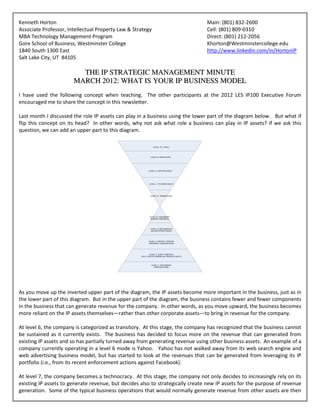
Q2 2012 IP Strategy Newsletter
- 1. Kenneth Horton Main: (801) 832-2600 Associate Professor, Intellectual Property Law & Strategy Cell: (801) 809-0310 MBA Technology Management Program Direct: (801) 212-2056 Gore School of Business, Westminster College Khorton@Westminstercollege.edu 1840 South 1300 East http://www.linkedin.com/in/HortonIP Salt Lake City, UT 84105 THE IP STRATEGIC MANAGEMENT MINUTE MARCH 2012: WHAT IS YOUR IP BUSINESS MODEL I have used the following concept when teaching. The other participants at the 2012 LES IP100 Executive Forum encouraged me to share the concept in this newsletter. Last month I discussed the role IP assets can play in a business using the lower part of the diagram below. But what if flip this concept on its head? In other words, why not ask what role a business can play in IP assets? If we ask this question, we can add an upper part to this diagram. As you move up the inverted upper part of the diagram, the IP assets become more important in the business, just as in the lower part of this diagram. But in the upper part of the diagram, the business contains fewer and fewer components in the business that can generate revenue for the company. In other words, as you move upward, the business becomes more reliant on the IP assets themselves—rather than other corporate assets—to bring in revenue for the company. At level 6, the company is categorized as transitory. At this stage, the company has recognized that the business cannot be sustained as it currently exists. The business has decided to focus more on the revenue that can generated from existing IP assets and so has partially turned away from generating revenue using other business assets. An example of a company currently operating in a level 6 mode is Yahoo. Yahoo has not walked away from its web search engine and web advertising business model, but has started to look at the revenues that can be generated from leveraging its IP portfolio (i.e., from its recent enforcement actions against Facebook). At level 7, the company becomes a technocracy. At this stage, the company not only decides to increasingly rely on its existing IP assets to generate revenue, but decides also to strategically create new IP assets for the purpose of revenue generation. Some of the typical business operations that would normally generate revenue from other assets are then
- 2. re-assigned to creating new IP assets. An example of a company operating in a level 7 mode is Rambus. This company does not actually sell any physical products, like memory devices. Instead, Rambus sells technology and know-how via licensing and enforcement. The company continues to perform R&D, but that R&D is used to create the technology and know-how, rather than the physical products themselves. At level 8, the company has moved into the realm of an opportunist. At this stage, the company has moved further away from traditional business operations and more towards generations of revenues from IP assets. The company now generates a majority of its revenue from IP assets. An example of this company was Acacia Research Corporation (ACTG) when it still contained an “operating unit” devoted to medical devices. Another example of this company would be Kodak, which still has some film operations but has been increasingly using its patent portfolio for revenue generation as its film business continues to shrink. At level 9, the company has become a privateer. As this stage, the company has stopped almost all business operations except for those assets used for generating IP assets. An example of a company operating in a level 9 mode is Intellectual Ventures (IV), which continues to perform R&D but that R&D is performed solely for the purpose of generating IP assets (i.e., brainstorming sessions). A distinction can be drawn between IV and Rambus in the purpose and use of their respective R&D. Rambus performs its R&D for the purpose of creating technology and know-how that can be incorporated into a physical product. The R&D of IV, on the other hand, is used for the purpose of creating the IP assets themselves. At level 10, the company has become the proverbial patent troll or NPE. The only business operations of the company are the acquisition and monetization of IP assets. There is no longer any development or creation of IP assets internally within the company. An example of a company operating in a level 10 mode is CIVIX-DDI, LLC since it’s only revenue comes from licensing and enforcing the patents. Another example of a level 10 company is the “new” Acacia Research Corporation. If you want another example, just look at the daily patent infringement cases filed around the country on any given day. The question that remains to be answered, though, is whether the profits generated from the upper part of the diagram can match the profits generated in the lower part of the diagram.